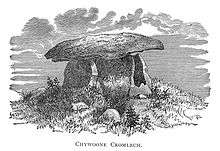William Copeland Borlase
| William Copeland Borlase | |
|---|---|
 William Copeland Borlase (c. 1880) | |
| Born |
5 April 1848 Castle Horneck, Penzance, Cornwall |
| Died |
31 March 1899 (aged 50) Bloomsbury, London |
| Residence | Laregan, Penzance[1] |
| Nationality | British |
| Occupation | Antiquarian and politician |
| Parent(s) | Samuel Borlase and Mary Anne née Copeland |
| Relatives | William Borlase |
William Copeland Borlase FSA (5 April 1848 – 31 March 1899) was an antiquarian and Liberal politician who sat in the House of Commons from 1880 until 1887 when he was ruined by bankruptcy and scandal.
Borlase was born at Castle Horneck, near Penzance in Cornwall, England, the only son of Samuel Borlase and his wife Mary Anne Copeland, daughter of William Copeland of Chigwell, Essex. A member of a wealthy Cornish family, Borlase's early life was much influenced by the archaeological work of his great-great-grandfather, Dr. William Borlase the Cornish historian. Young Borlase visited many of the ancient sites in Cornwall and in 1863 and supervised the excavations of the re-discovered prehistoric settlement and fogou at Carn Euny. Although Borlase produced many sketches he commissioned fellow Cornish antiquarian John Thomas Blight to do the engravings for the report. Borlase was educated at Winchester College and Trinity College, Oxford. He was called to the bar at Inner Temple in 1882 and was JP for Cornwall and a Deputy Warden of the Stannaries of Cornwall and Devon.[2]
In the 1880 general election, Borlase was elected Liberal Member of Parliament for East Cornwall, until the seat was divided in the Redistribution of Seats Act 1885. In the 1885 general election, he was elected MP for St Austell.[3] In 1886 he was made Parliamentary Secretary to the Local Government Board. However he took to fine living. His Portuguese mistress exposed his debts and the scandal brought him ruin and bankruptcy.[4] He resigned his seat in the House of Commons and went off to work in Ireland as a remittance man. He also went on to manage tin mines in Spain and Portugal. The rest of the family disowned him and he died aged just 50. His address when he died was 34, Bedford Court Mansions, Bloomsbury, in London.
Works

- 1862 – 1864: An Account of Excavations at Carn Euny
- 1871: Ancient Cornwall. 2 vols.
- 1872: Nænia Cornubiæ: a descriptive essay, illustrative of the sepulchres and funereal customs of the early inhabitants of the county of Cornwall. London: Longmans, Green (Reissued: ISBN 978-1-897853-36-8)
- It has been estimated that Borlase excavated about 200 barrows in Cornwall but he has been criticised for poor archaeological practice, particularly in only writing accounts of a tenth of the barrows.[5]
- 1874: Historical sketch of the tin trade in Cornwall: a lecture. Plymouth.
- 1876: Niphon and its antiquities: an essay on the ethnology, mythology and religions of the Japanese. Plymouth.
- 1895: The Age of the Saints: a monograph of early Christianity in Cornwall with the legends of the Cornish saints and an introduction illustrative of the ethnology of the district. Truro: Joseph Pollard (Reissued: ISBN 978-1-897853-86-3)
- 1897: The Dolmens of Ireland, their Distribution, Structural Characteristics, and Affinities in Other Countries; together with the folk-lore attaching to them and traditions of the Irish people. 3 vols. London: Chapman & Hall (Reissued: ISBN 978-0-543-78444-5)
References
- ↑ "Excavations at St Just". The Cornishman (11). 26 September 1878. pp. 4–5.
- ↑ Debrett's Guide to the House of Commons; 1886
- ↑ Hansard 1803–2005: contributions in Parliament by William Borlase
- ↑ "The Bankruptcy of Mr. W. C. Borlase"--The West Briton; Monday 14 November 1887
- ↑ Marsden, Barry M. (1974) The Early Barrow-Diggers. Princes Risborough: Shire; pp. 82–89, 118
- Cooke, Ian McNeil Mother and Sun: the Cornish fogou; pp. 27–28
External links
| Wikimedia Commons has media related to William Copeland Borlase. |
- Hansard 1803–2005: contributions in Parliament by William Copeland Borlase
- Naenia Cornubiae from The Internet Archive
| Parliament of the United Kingdom | ||
|---|---|---|
| Preceded by Sir Colman Rashleigh and John Tremayne |
Member of Parliament for East Cornwall 1880 – 1885 With: Thomas Agar-Robartes 1880–1882 Charles Thomas Dyke Acland 1882–1885 |
Constituency abolished |
| New constituency | Member of Parliament for St Austell 1885 – 1887 |
Succeeded by William Alexander McArthur |